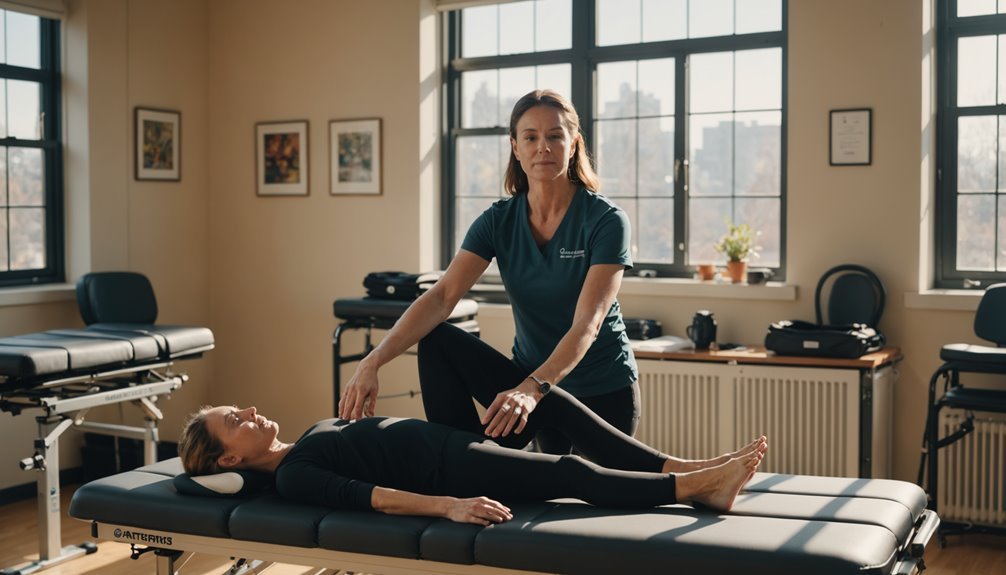When you’re faced with an injury, it’s vital to understand the steps involved in effective rehabilitation. You might think it’s just about resting, but there’s a lot more to think about, like the types of exercises and strategies that can aid in recovery. Have you ever wondered why a tailored rehabilitation plan is essential for minimizing the risk of re-injury? It’s not just about getting back on your feet quickly—it’s about ensuring long-term health and performance. Let’s explore how a structured approach can make all the difference in your recovery journey.
Key Takeaways
- Implement the RICE method initially to manage inflammation and pain in acute injuries.
- Focus on range of motion exercises to enhance flexibility during rehabilitation.
- Strength training should progress gradually from isometric contractions to using resistance bands and weights.
- Regularly assess recovery progress to adjust the rehabilitation program as needed.
- Incorporate balance exercises to improve proprioception and support overall recovery.
Types of Injuries

When it comes to understanding injury rehabilitation, knowing the types of injuries is vital. You’ll encounter two primary categories: acute injuries and overuse injuries. Acute injuries occur suddenly, typically from an external force, like when you twist your ankle and end up with a sprain, or when you experience a fracture from a fall. These injuries demand immediate attention and a tailored rehabilitation process to restore your mobility and strength effectively.
On the other hand, overuse injuries develop over time due to repetitive stress on your muscles and joints. If you’re an athlete engaged in frequent training, you might face issues like tendinitis or stress fractures. Recognizing these injuries early is significant as the rehabilitation process often involves modifying your activity levels and gradually reintroducing stress to the affected areas.
Understanding the nuances of sprains and strains is important too. Sprains involve ligaments, while strains affect muscles or tendons. Each requires specific rehabilitation strategies to guarantee full recovery.
For fractures, whether closed or open, the focus is on regaining strength and mobility post-immobilization. Concussion rehabilitation, meanwhile, is more multidisciplinary, addressing physical, cognitive, and emotional aspects to guarantee a safe return to activities.
Initial Response Steps
A swift and thoughtful response to an injury can greatly influence the recovery trajectory. The initial response is essential, and acting promptly with the right steps can set the stage for a smoother healing process.
First, it’s important to limit the use of the injured area immediately. This prevents further damage and any potential complications that could arise from continuing to strain the area.
The RICE method—Rest, Ice, Compression, Elevation—should be among your first actions. Resting the injured area reduces stress on it, allowing the body to start the healing process.
Applying ice for 15-20 minutes at a time, several times a day, can notably reduce inflammation and alleviate pain, acting as an early intervention that leads to better outcomes. Compression helps minimize swelling, while elevation encourages fluid drainage away from the injury.
After applying the RICE method, arrange for a medical consultation. Although the RICE method is a valuable first step, a sports medicine doctor can provide an accurate diagnosis and outline appropriate treatment options.
Taking these initial response steps seriously can make a considerable difference in your overall recovery journey.
Medical Consultation Importance

When you schedule a timely appointment with a sports medicine doctor, you guarantee an accurate diagnosis, which is essential for effective treatment.
Consulting a medical professional helps identify the injury’s severity, allowing for a tailored rehabilitation strategy.
With professional guidance, you gain a clear understanding of necessary recovery methods, promoting adherence and reducing the risk of re-injury.
Accurate Diagnosis Benefits
For effective injury rehabilitation, getting an accurate diagnosis from a sports medicine doctor is vital. This diagnosis determines the specific type and severity of your injury, which directly shapes your rehabilitation program.
A sports medicine physician plays an important role here, using their expertise to pinpoint underlying issues that might contribute to your condition. By addressing these factors early on, you can adopt an all-encompassing approach that not only aids recovery but also prevents future injuries.
An accurate diagnosis is your gateway to personalized recovery methods. Whether it’s physical therapy, medication, or even surgery, a tailored plan guarantees that you’re on the right path to healing.
Understanding the nature of your injury means you can set realistic recovery goals and timelines. This knowledge enhances your motivation and helps you stay committed to the rehabilitation process, knowing exactly what to expect.
Moreover, having professional guidance minimizes the risk of mismanaging your injury. A sports medicine doctor helps you navigate the complexities involved, securing a safer return to your activities.
Their insights reduce the chances of setbacks, making your journey back to sports smoother and more effective. Trust in their expertise to steer your recovery in the right direction.
Effective Treatment Guidance
In the domain of injury rehabilitation, seeking timely medical consultation with a sports medicine doctor is vital for guaranteeing an effective treatment plan. You’ll benefit from an accurate assessment and diagnosis, which are essential for tailoring a personalized treatment plan to your specific injury. During your appointment, the doctor will discuss the severity of your injury and outline a recovery timeline that aligns with your individual needs and goals. This professional guidance helps prevent mismanagement of the injury, reducing the risk of long-term complications.
Sports medicine experts often use imaging tests to provide a thorough view of the injury. These tests are indispensable in crafting a precise rehabilitation plan. Understanding the injury through professional assessment allows you to make informed decisions, promoting a safer return to sports.
Here’s what you might expect from a medical consultation:
| Key Aspect | Description |
|---|---|
| Assessment and Diagnosis | Accurate evaluation of injury using clinical expertise and imaging tests |
| Personalized Treatment Plan | Treatment tailored to injury specifics and personal recovery goals |
| Rehabilitation Plan | Structured program to restore function and prevent re-injury |
| Long-term Risk Management | Strategies to avoid complications and guarantee sustainable recovery |
Engaging a sports medicine doctor in your rehabilitation journey guarantees that every step is optimized for success.
Cold Therapy and Compression
When you’re dealing with an injury, using cold therapy for 15-20 minutes several times a day can help reduce swelling and pain effectively.
Make sure to avoid direct ice contact with your skin by using a cloth or towel, and apply a compression bandage that’s snug but not too tight.
Reducing Swelling Effectively
To effectively reduce swelling from an injury, you should use a combination of cold therapy and compression. Applying ice for 15-20 minutes several times a day is key to reducing swelling and managing pain. The cold constricts blood vessels, which helps control inflammation and minimize tissue damage. Pairing this with compression, like a snug bandage, maintains consistent pressure on the area, aiding in further swelling reduction. However, verify the bandage isn’t too tight, as this could restrict blood flow.
Utilizing both these methods in conjunction with elevation amplifies their benefits. When you elevate the injured area above your heart level, it reduces blood flow to the site, enhancing the effectiveness of the cold therapy and compression. This trio is part of the RICE method, a tried-and-true approach for acute injuries.
| Method | Benefit |
|---|---|
| Ice | Reduces swelling and inflammation |
| Compression | Maintains pressure, reduces swelling |
| Elevation | Decreases blood flow to injury |
| RICE Method | A holistic approach to healing |
Optimal Icing Duration
One essential aspect of injury rehabilitation is understanding the ideal duration for icing. To achieve the best icing duration, you should aim for 15-20 minutes per session. This timeframe helps you effectively reduce swelling and pain without risking frostbite.
Here’s how to make the most of cold therapy:
- Session Frequency: Repeat your icing sessions several times a day, especially during the first 48 hours post-injury. This is when swelling peaks and consistent cold therapy is most effective.
- Barrier Protection: Always use a cloth or towel as a barrier between the ice and your skin. This prevents frostbite while still allowing the cold to penetrate and provide therapeutic benefits.
- Combine with Compression: Although we’ll focus on compression techniques later, remember that combining cold therapy with compression can enhance swelling reduction. Proper compression helps constrict blood vessels, reducing fluid accumulation around the injury.
Proper Compression Techniques
After understanding the ideal duration for icing, it’s important to focus on the role of proper compression techniques in injury rehabilitation. Using a compression bandage that’s snug but not overly tight is essential in controlling swelling.
Combining cold therapy with this compression enhances their effectiveness, helping to reduce both swelling and pain. This synergy can initiate the healing process more quickly, guaranteeing you recover efficiently.
To achieve the best results, apply ice for 15-20 minutes, then follow it with a compression wrap. You should repeat this process several times a day. This routine helps maintain consistent pressure on the injured area, vital for reducing excess fluid build-up.
Remember, elevation plays a key role too. By keeping the injured area elevated above heart level while applying compression, you further reduce blood flow, minimizing swelling considerably.
Take precautions to avoid direct skin contact with ice; use a cloth or towel as a barrier to prevent frostbite. Additionally, regularly check circulation to confirm the compression isn’t too tight, as this can lead to complications.
Rehabilitation Exercises

In the domain of injury rehabilitation, a well-structured exercise program plays a vital role in restoring your strength, flexibility, and functionality. Rehabilitation programs start with low-resistance movements, gradually advancing as your recovery progresses.
Initially, you’ll focus on increasing your range of motion with stretching exercises held for at least 30 seconds. This approach effectively improves flexibility, allowing your body to regain its full potential.
Strength training is another essential component. You’ll begin with isometric contractions, which involve tightening muscles without movement. As your condition improves, you’ll incorporate resistance bands, free weights, and even sport-specific drills to build strength. These exercises are tailored to your needs, guaranteeing you safely regain muscle power.
To paint a clearer picture, consider these key exercises:
- Range of Motion: Stretching techniques focusing on flexibility.
- Strength Training: Isometric contractions progressing to weighted exercises.
- Proprioception: Single-leg stands and balance exercises on unstable surfaces.
Finally, regular assessments and modifications to your rehabilitation program guarantee it aligns with your recovery stage and goals. This dynamic approach optimizes your healing process, restoring confidence in your body’s capabilities.
Injury Prevention Strategies
Anyone involved in physical activities knows the importance of injury prevention strategies in maintaining peak performance and long-term health. By incorporating effective injury prevention techniques, you can markedly reduce the risk of setbacks.
Start with a proper warm-up routine that includes dynamic stretching. This enhances muscle elasticity and prepares your body for the demands of physical activity, reducing your chances of getting hurt.
Using protective gear is essential, especially if you’re into contact sports. Helmets and pads can decrease the incidence of acute injuries by up to 60%. It’s a small step that makes a big difference in your safety and athletes’ quality of life.
Also, consider cross-training to prevent overuse injuries. By varying your workouts, you allow different muscle groups to rest, maintaining overall fitness while minimizing injury risks.
Consistent strength training focusing on core stability and joint support can lower injury risks by up to 30%. These exercises not only strengthen your body but also form a key part of rehabilitation techniques.
Finally, learn to recognize early signs of discomfort or fatigue. Timely interventions can prevent injuries from worsening, ensuring that you maintain your health and athletic performance.
Frequently Asked Questions
What Are the 4 Phases of Injury Rehabilitation?
You’re asking about the four phases. First, manage pain and swelling. Next, improve the range of motion. Then, focus on strength and proprioception. Finally, advance to sport-specific training. Always assess progress and adjust as necessary for success.
What Are the Three Types of Rehabilitation?
You’ve got three main types of rehabilitation to focus on: physical, occupational, and cardiac. Each targets different aspects of recovery, helping you regain strength, return to daily activities, and improve heart health effectively.
What Are the 3 Levels of Rehabilitation?
You’re asking about the three levels of rehabilitation. They consist of initial, intermediate, and advanced stages. Each level targets specific recovery goals, such as managing symptoms early on and gradually enhancing strength and functional abilities.
How to Recover an Injury Faster?
To recover faster, start the RICE method immediately, see a sports doctor for a plan, apply cold therapy, and do recommended exercises. Eat a balanced diet and stay hydrated to support healing and reduce inflammation.
Conclusion
In your injury rehabilitation journey, embracing a structured plan is vital for a full recovery. You need to prioritize seeking medical advice to guarantee an accurate diagnosis and a tailored approach. Don’t overlook the importance of cold therapy and compression in the initial stages. Engage actively in rehabilitation exercises that focus on range of motion, strength, and proprioception. By committing to these steps, you’ll not only heal effectively but also reduce the risk of future injuries, safeguarding your long-term health.

